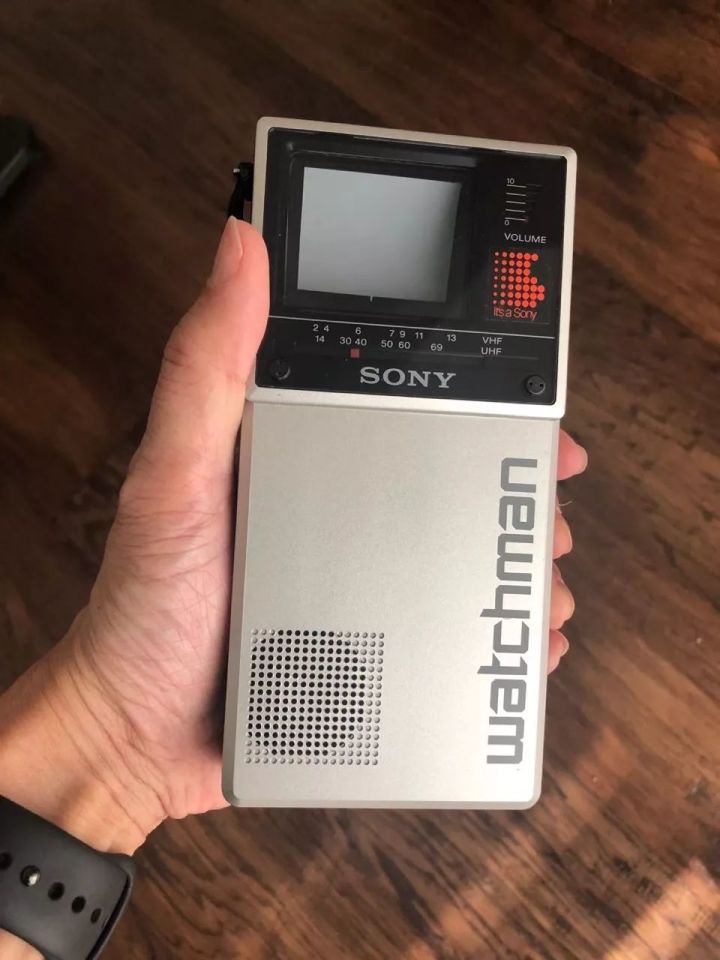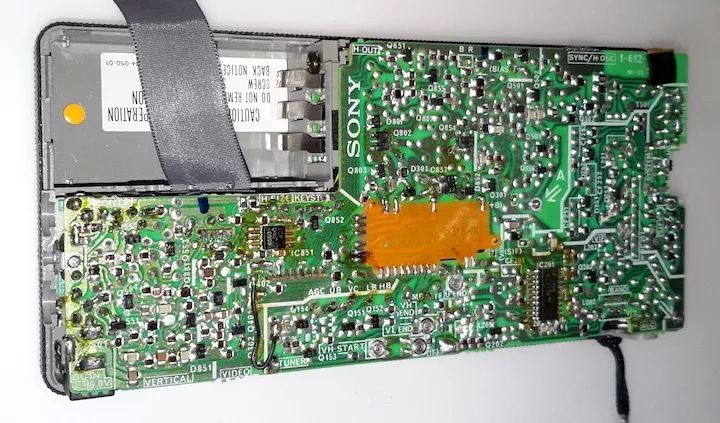Recently, I watched a disassembly video of the iPhone 11 and wanted to compare it to another pinnacle of technology that was created more than 30 years ago: the Watchman.
Everyone knows about Sony’s Walkman portable music player, but very, very few have likely heard of the Watchman.
So what is Watchman?
“Watchmaker?”
In the early 1980s, extremely wealthy Chinese families would probably have a 9-inch or 12-inch black and white television, attracting relatives from several miles away to gather and watch shows like “Zi San Si Lang” and “Huo Yuan Jia."(Earliest Japanese TV dramas introduced to China)
At that time, we knew nothing about holding a television, one can only say that poverty limited imagination.
Watchman was born in 1982, producing a total of up to 65 models. The one I recently discovered is from the 1985 version.

For reference only, please disregard my beautiful hands.
Are you curious about how it manages to fit the CRT cathode ray tube and tuner inside, and then drive the high voltage package with four 5th size batteries?
One, Link to heading
In China, the Walkman enjoyed a higher status than today’s iPhone, and students who owned a Walkman probably felt as proud as someone who owns a Mercedes-Benz today.
Before the emergence of mobile internet, ordinary people’s entertainment was mainly focused on the audio-visual (AV) industry. And in this field, the overlord was undoubtedly Sony.
“Sony is perhaps the predecessor of Apple.”
Similar to Apple, almost all of Sony’s products are more expensive than other brands.
Although it may be more expensive, choosing Sony is always a safe bet.
This is the origin of the “Sony Philosophy of Trust and Credibility,” and it is also the most down-to-earth translation of Sony’s slogan, “Make.Believe.”
As usual, let’s briefly review some history that interests me and then take a look at the disassembly diagram of Watchman.
Two. Link to heading
In 1963, Philips developed the small cassette tape that we have been using since then. Japanese manufacturers agreed to pay a licensing fee of 6 yen per cassette, except for Sony.

Dahe Dianxiong actually managed to convince Philips to waive patent royalties worldwide in the end.
Dahe was not brought by Jing Shen and Sheng Tian, but was invited by Steve Jobs and it took him 10 years to convince him to join.
Although Philips earned much less money, perhaps it was a case of recognizing heroes in each other. From then on, the two companies became staunch allies in the CD, VCD, DVD, and Blu-ray standards war, achieving complete victory.
After the development of small laser disc technology by Philips at Natlab (insert advertisement: another book by author René, “ASML’s Architects”), Daher flew specifically to Eindhoven to see it and was impressed.
Both parties collaborated in formulating the CD standard, with Sony providing digital audio technology and enhanced system design based on the laser and optical technologies provided by Philips.
The original design of Philips CD was to play for one hour with a diameter of 11.5 centimeters. However, as a musician, Dekei Norio insisted stubbornly on recording the complete Beethoven’s Ninth Symphony.
Philips pursued a smaller size and repeatedly opposed the idea of carrying a CD in one’s pocket, but eventually yielded and added an extra circumference of 12 centimeters, resulting in approximately 75 minutes of playtime. And that is the size of today’s CD.
Sony CD players were introduced in the early 1980s. However, they did not exist for the Chinese people who had just emerged from adversity during that time.
Until the 1990s, we were still listening to cassette tapes.
Three, Link to heading
In MBA case studies from 20 years ago, the battle between Sony’s Betamax and JVC’s VHS videotapes was always discussed. However, history has taught us that temporary victories and defeats are not important.
It seems that the Japanese did not regret losing the Battle of Midway. They only took 30 years to rise back to the forefront of the world.
Sony, born from the ruins of defeat in 1946, had its first product as a failed rice cooker.
By 1975, the ownership rate of color TVs in Japanese households had already exceeded 90%.
Video recorders have become a new hot topic. However, American companies led by Universal Studios have accused Sony of claiming that owning a VCR is illegal because recording television programs is a form of infringement.
The lawsuit lasted for 8 years and even reached the United States Supreme Court. In the end, the justices ruled in favor of Sony with a narrow 5-4 decision. Time-shift was deemed a valid reason.
But Sony was not the beneficiary in this lawsuit, as it lost the videotape war.
After the failure of Betamax in the 1980s analog era, VCD, created by the Sony Philips alliance, became a short-lived digital standard in the 1990s.
Due to the significantly lower cost of pirated copies compared to VHS tapes, VCDs facilitated China’s leap from analog to digital.
Low quality VCD discs caused companies such as Ai Duo and Bu Bu Gao, which have strong error correction capabilities, to soar to success.
Due to the large inventory of video recorders and videotapes in the United States, VCDs with low picture quality did not become popular.
In the upcoming DVD standard battle, Sony and Philips joined forces to compete against Toshiba, Panasonic, Pioneer, and JVC. However, with the intervention of computer giants such as IBM, Microsoft, and HP, the conflict ultimately did not escalate into a physical confrontation.
Ten years later, Sony and Philips teamed up to fight again with Blu-ray, but the opposing HD DVD camp was stronger. This time, Toshiba was backed by Intel and Microsoft, as well as Universal, Paramount, and Warner Bros.
As a result, Sony made a determined effort and provided a huge subsidy for PS3, making it the most cost-effective Blu-ray player, winning hands down.
However, streaming media has begun to dominate the market, with Japanese home appliances becoming marginalized.
Bu Bu Gao relied on Blu-ray technology to cultivate international talents for OPPO and later OnePlus smartphones.
It can only be described as “the vicissitudes of life.”
Four, Link to heading
Sony has released far far far too many products, with so many that they cannot be listed on their own historical website, and even Tokyo’s Sony Museum has barely scratched the surface.
It seems that Sony is not nostalgic; innovation is still in its DNA.

Numerous online articles have provided seemingly rational analyses of the rise and fall of Sony. Unfortunately, I must say that I haven’t come across a truly insightful piece on the matter.
Next, let’s take a look at how this compact Watchman conceals a universe of possibilities inside its small body.

The main circuit board looks quite standard, after all it was from that era, with only one or two chips.

The high voltage part below is a bit scary, with the warning on the casing stating “Prevent Electric Shock”. Here, several dry batteries are combined to produce a voltage of 370 volts.

If opened again, one can appreciate the horizontally placed cathode ray tube and a tangled mess representing the culmination of analog era.
It should be said that designing such a pocket-sized machine requires more experience than designing a digital circuit product at present.
Fortunately, besides needing to catch up on some training for simulation devices, our engineers have mostly skipped that era.
Sony has maintained an unbeatable hardware strength for the past half century, but unfortunately, always lacking another gene: software.